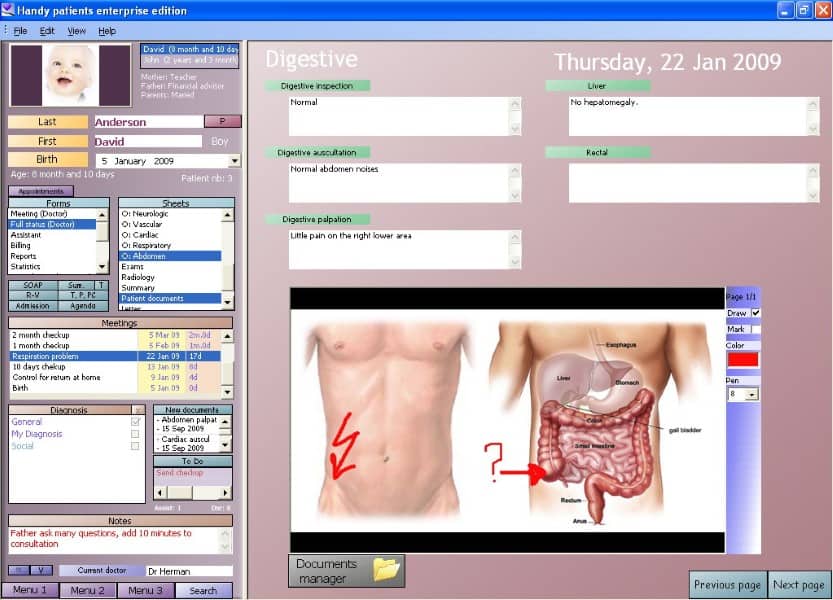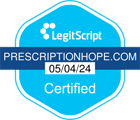Does My Doctor Know If I Filled My Prescription? What Do They Know?
Posted by Prescription Hope - See Editorial Guidelines (Last Updated On: Wed Apr 26 2023)
Have you ever wondered if your doctor can trace whether you’ve filled your prescription? Our article below explores some of the ways in which your physician can track prescriptions. Here’s the quick answer…
Does my doctor know if I filled my prescription? Many pharmacies use a system called EHR (Electronic Health Record) These digital records include medical data, prescriptions that were filled at pharmacies, giving your Doctor access to prescription filled details. Alongside EHR, a doctor can contact the pharmacy that a patient has been known to use.
Let’s take a closer look at Electronic Health Records to help us more fully understand how a doctor can find out if you’ve filled your prescription.
What is an EHR?
Here’s a sample of an EHR on-screen Record.

An electronic health record (EHR) is a record of a patients information – which allows the record to be kept securely and available Instantly.
An EHR is a more broad view of a patient’s care package and although it does contain a comprehensive overview of the medical history and any prescribed treatments of a patient, it is designed to reach beyond basic clinical data that is normally collected in a health provider’s office.
An EHR will normally include the following information:
- Gives the Healthcare Provider access to tools that will enable them to make decisions with regards to the patient’s care
- Creates a more streamlined workflow by automating all processes a provider may be required to deliver
- Details of treatment plans, medications, any immunizations, full medical history, diagnoses, any laboratory or test results that were undertaken, allergies and radiology images
‘One of the key features of an EHR is that health information can be created and managed by
authorized providers in a digital format capable of being shared with other providers across
more than one health care organization.’ HealthIT.gov
An EHR will contain the information captured from all the clinicians and health providers who may be involved in the care of a patient. The information can then be shared with other providers caring for the patient. These will include:
- Emergency facilities
- Laboratories
- Specialists
- Medical imagery providers
- Pharmacies
- Work and school medical clinics
To help us to further understand whether a doctor can tell if we have filled our prescription, let’s take a look below at how long pharmacies have to keep your medical records, including your prescriptions. These are the guidelines which we’ve outlined in simple terms.
| Record | What is it / Information Contained | Retention Period |
| Prescriptions | A hard copy record of a prescription | 42 months, or 2 years past the completion of therapy |
| Patient Record | Contains: Demographics, Drug Profile, Record of Care Provided | 10 Years past the last date of Pharmacy Service Provided or 2 years past age of Majority |
| Record of Care | Includes Records of – Drug therapy, problems, interventions & Monitoring
Prescriptions and other prescribed & injected Summaries of Consultations, Prescriptions NOT Filled | 10 Years past the last date of Pharmacy Service Provided or 2 years past the age of majority |
| Drug Error | Incidents and adverse drug effects, adverse outcomes | 10 years after the error is discovered |
| Health Info Disclosure | Records of diagnosis, treatment, and care. Or records info shared with other health organizations | 10 years following the date of disclosure |
| Narcotic Receipts | Records narcotics received at a pharmacy or licensed outlet, such as a wholesaler | 2 years from the date of the receipt |

How Long Does a Pharmacy Keep My Prescription For?
Pharmacies keep a hard copy of prescriptions. If the physician provided the patient with a hand-written script, the physician can contact the pharmacy to confirm that the script was filled.
If the physician electronically sends the prescription directly to a pharmacy, referred to as “e-Prescription” or “e-Rx”, the e-Rx program allows doctors to receive a notification indicating whether or not the prescription had been picked up, not picked up, or partially filled.
Let’s take a look at other ways doctors can see if you’ve filled your prescription.
Other Ways Doctors Can Track Your Medication

More than three dozen states and seven provinces in Canada have established databases to help track opioid, and narcotic drug prescriptions.
These databases track doctors’ prescription-writing, pharmacy prescription-dispensing, and patients’ prescription filling.
When a patient sees his or her doctor, and the possibility exists for writing a pain-relieving prescription drug, then the doctor will be able to access the database to be sure that patient is not attempting to “doctor shop” amassing more prescription drugs than he is legally or medically entitled to, or which can be of danger to him if he overdoses.
Discussions are underway to make sharing this information possible across state lines so patients cannot go ‘doctor shopping’ in other states.
While many patients are upset that such a database violates their privacy, there are actually important reasons to support the use of this kind of tool.
Discussions are underway to make sharing this information possible across
State lines, so patients cannot go doctor shopping in other states!
Doctors will be able to more confidently prescribe drugs for appropriate patients, at appropriate times, with less fear that they can get into legal trouble.
When emergency room personnel can access such a database, patients who go to the ER will be less likely to be prescribed drugs that will conflict with the pain drugs they already take. Or, those same patients will be less likely to be dismissed by their regular doctors if they’ve been to the ER for some other reason.
Many patients continue to take pain-relieving drugs when they think they’re dependent on them, even when they’re not. Patients who’re capable of being weaned off these drugs will be compelled to do so, even when they think it’s impossible. Doctors will have complete information about their patients’ pain drug history, including prescriptions written by other doctors, prior to their relationship with the patient.
Why Don’t People Fill Their Prescriptions?
According to the NCBI, approximately 50% of patients do not take their medications as prescribed.
There are many reasons why you might not fill your prescription. Let’s take a look below at some of the more common ones.
9 Reasons Patients Do Not Fill or Take Their Medications
- Cost. Patients may not fill medications at all due to affordability issues. Or they may reduce taking meds in order to extend the supply they currently have.
- Fear. Potential side effects can often put patients off filling their prescription. Perhaps they have experience of friends or family who have bad experiences with the drug. Or perhaps heard of alleged horror stories pertaining to the effectiveness of the meds.
- Misunderstanding. Patients may interpret the need for the meds as unnecessary or non-essential to improving their health. This can often be the case for patients suffering from chronic or long term illnesses. If the patient doesn’t experience any immediate improvements, then it may lead to prematurely discontinuing the medication.
- Too many medications. The greater the variety of meds prescribed, along with a higher dosing frequency means the patient is more likely to be non-adherent.
- Lack of symptoms. If the patient feels that symptoms have disappeared, they may then believe the illness has ended and feel little need to spend money on further meds.
- Denial. Patients believe that it will all ‘go away’ of its own accord. So they feel there’s no need for medication.
- Worry. Dependency can be a concern, patients are often reluctant to start using a drug they feel they may become dependent on. This can also contribute to non-adherence.
- Depression. Depression can promote a lack of importance on health issues. Leading to patients being less likely to fill their medications.
- Mistrust. Patients may be suspicious or doubting of their doctor’s diagnosis or even their motives for prescribing certain meds. Possibly because of their own beliefs about what they’re suffering from, or due to news reports, or any perceived influence on the physician to prescribe certain drugs by pharmaceutical companies.
“If they do not fully understand the reason that they’re being prescribed the medication, they may be less likely to take it,” lead researcher Dr. Michael A. Fischer, of Brigham and Women’s Hospital in Boston, told Reuters Health.
“If you are not sure why you are being prescribed a medication, ask your doctor directly,” he said. “One of our jobs as physicians is to educate and advise our patients.’
So, if you feel you’re being prescribed medicines that you are unsure of, make sure you speak to your doctor about it.

What Consequences Are There of Not Filling My Prescription?
Read below some interesting research with regards to unfilled prescriptions and how not following your doctor’s advice with regards to filling your prescription can have far-reaching consequences both on your health and the economy. This is more formally known as ‘medical non-adherence.’
Medication Non-Adherence
According to a study by The National Council on patient information and education, as many as half of all patients did not follow their doctors’ advice when it came to medications. Studies which have looked into patients who took regular medication for long term diseases such as high blood pressure and diabetes and who were non-adherent in filling their prescriptions were more likely to be iller, have increasingly higher mortality rates and suffer more from other complications surrounding their illness.
The overall cost of medication nonadherence is staggering. This issue amounts to more than $170 billion each year in the United States alone, some reports say this figure could be as high as $300 billion.
Recent Research on Medical Non-Adherence
Much of the research on non-adherence has centered around the situation occurring around patients who have filled their prescriptions. Questions such as:
- Have they come back for more refills?
- Are they regularly taking their medication?
As there are now many better-tracking systems available and more healthcare providers using electronic medical records, it has been discovered that non-adherence may begin before the patient has filled their prescription.
‘Researches at Harvard Medical School published the largest study to date of what has been termed “primary nonadherence” and found that more than 20% of first-time patient prescriptions were never filled.’
First-time prescriptions for chronic diseases like high cholesterol, high blood pressure, and diabetes were more likely not to be filled, whereas those for pediatric patients 18 years of age and younger and for antibiotics were more likely to be filled.

Conclusion
In conclusion, there are ways in which your doctor can track your medication ranging from databases to your medical records. If you are ever having trouble affording the medication you have been prescribed, visit us online to fill out an application and start saving.
ENROLL



